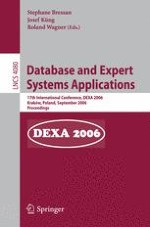The annual international conference on Database and Expert Systems Applications (DEXA) is now well established as a reference scientific event. The reader will find in this volume a collection of scientific papers that represent the state of the art of research in the domain of data, information and knowledge management, intelligent systems, and their applications. The 17th instance of the series of DEXA conferences was held at the Andrzej Frycz Modrzewski Cracow College in Kraków, Poland, during September 4–8, 2006. Several collocated conferences and workshops covered specialized and complementary topics to the main conference topic. Four conferences ? the 8th International Conference on Data Warehousing and Knowledge Discovery (DaWaK), the 7th International Conference on Electronic Commerce and Web Technologies (EC-Web), the 5th International Conference on Electronic Government (EGOV), and the Third International Conference on Trust, Privacy, and Security in Digital Business (TrustBus) ? and 14 workshops were collocated with DEXA. The whole forms a unique international event with a balanced depth and breadth of topics. Its much-appreciated conviviality fosters unmatched opportunities to meet, share the latest scientific results and discuss the latest technological advances in the area of information technologies with both young scientists and engineers and senior world-renown experts. This volume contains the papers selected for presentation at the conference. Each submitted paper was reviewed by three or four reviewers, members of the Program Committee or external reviewers appointed by members of the Program Committee.
